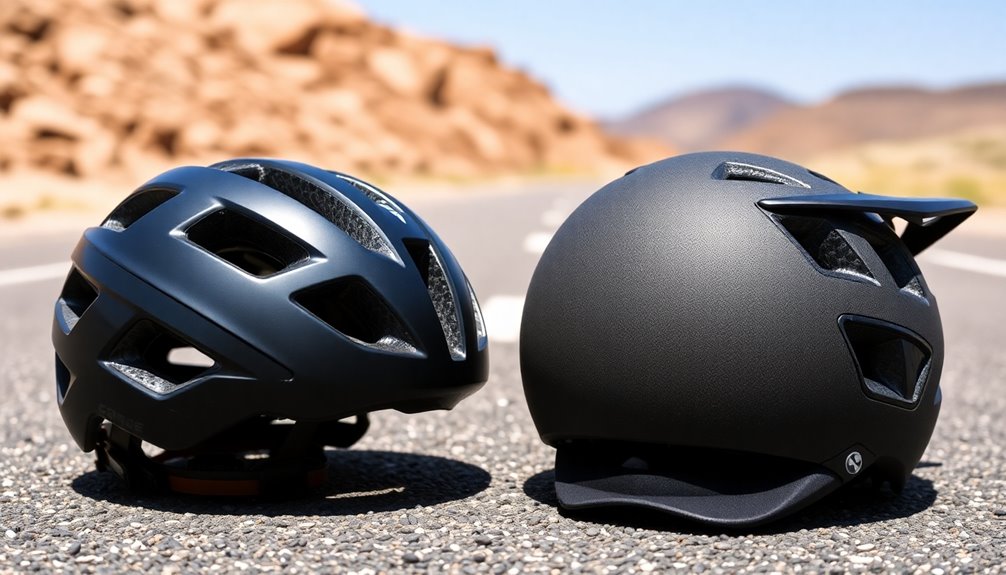When choosing between road and mountain bike helmets, you'll notice key differences in design and features. Road helmets are lightweight, aerodynamic, and ventilated for speed, making them ideal for urban and smooth surfaces. Mountain helmets, on the other hand, offer bulkier protection with thicker padding and visors for rugged terrains. Both meet safety standards, but your choice should depend on your riding style and environment. Continue exploring to uncover more about which helmet suits your needs best.
Key Takeaways
- Road bike helmets are lightweight and aerodynamic, prioritizing speed with numerous ventilation holes for better airflow during long rides.
- Mountain bike helmets provide enhanced protection with bulkier designs, thicker padding, and extended rear coverage for safety on rugged terrains.
- Both helmet types meet strict safety standards, but mountain bike helmets often comply with ASTM F1952 for off-road impact resistance.
- Road helmets are favored for urban and smooth surfaces, while mountain helmets are better suited for uneven, trail environments.
- Personal preferences and riding style significantly influence helmet choice, balancing comfort, protection, and the intended riding conditions.
Design and Structure
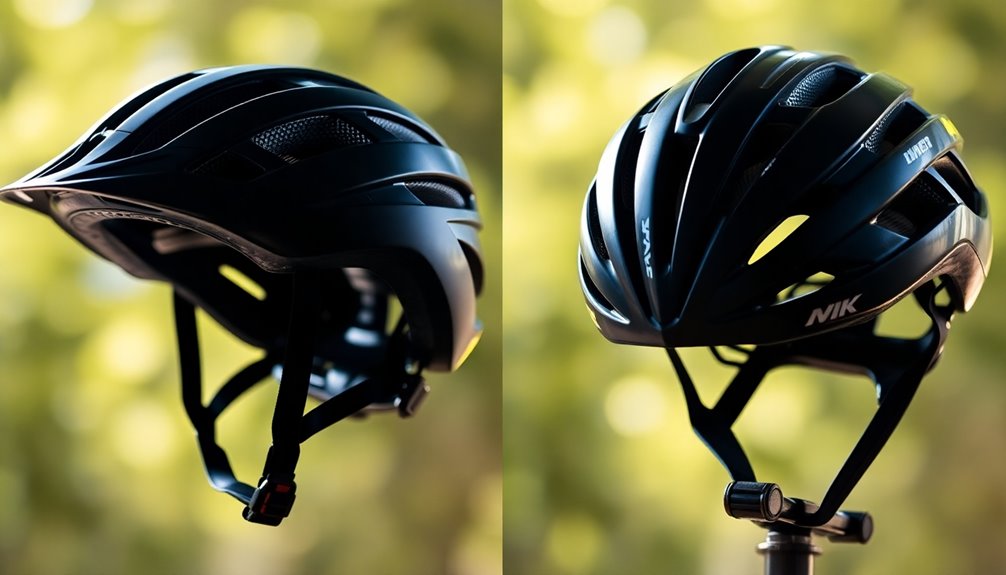
When it comes to bike helmets, the design and structure play an essential role in your safety and comfort.
Road bike helmets feature a streamlined, aerodynamic design that minimizes wind resistance, allowing you to maintain speed on paved surfaces. Their lighter weight and increased ventilation holes help keep you cool during long rides.
On the other hand, mountain bike helmets have a bulkier structure, providing enhanced protection and coverage against falls on uneven terrain. The extended rear coverage safeguards the back of your head, an essential feature for trail riding.
Additionally, mountain bike helmets often include visors to protect your eyes from sunlight and debris, striking a balance between safety and visibility while you navigate challenging trails.
Ventilation and Cooling

How important is ventilation when choosing a bike helmet? It's essential for your comfort and performance.
Road bike helmets excel in this area, featuring larger, more numerous vents to enhance airflow and regulate temperature during long, high-speed rides. This design often includes moisture-wicking interior padding, which helps manage sweat and improve cooling.
On the other hand, mountain bike helmets have smaller vents that prioritize protection and structural integrity while keeping dirt and mud out. Their ventilation system allows air to flow in through front vents and exit through the rear, balancing airflow with safety.
Some road bike helmets even incorporate advanced cooling technologies, providing extra comfort during intense rides.
Ultimately, effective ventilation enhances your overall biking experience.
Weight and Aerodynamics
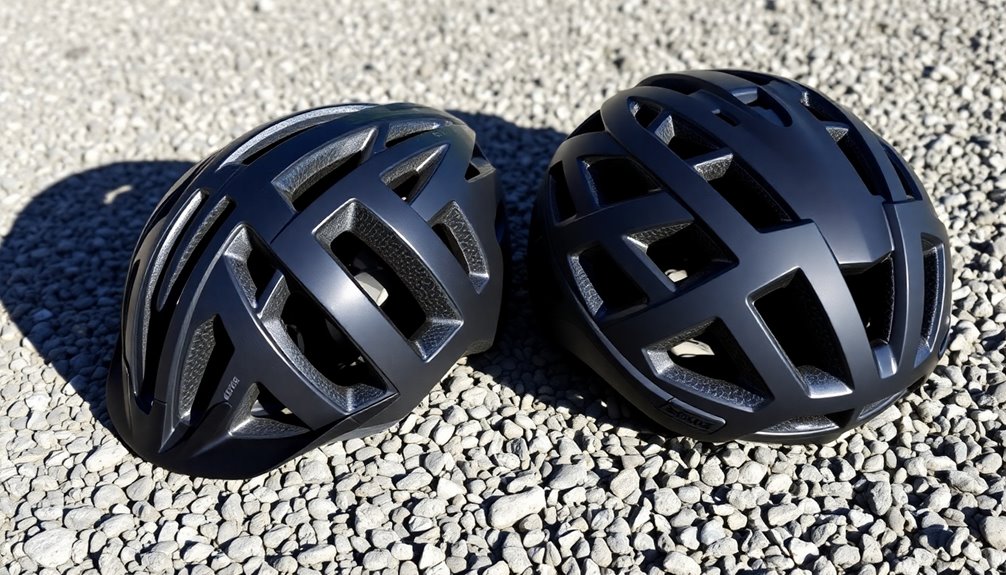
When choosing a bike helmet, weight and aerodynamics play an essential role in your performance.
Road bike helmets are typically lighter and designed to reduce drag, helping you reach higher speeds.
In contrast, mountain bike helmets prioritize protection, which can add weight but may affect your overall efficiency on the road.
Helmet Weight Comparison
Weight plays an essential role in the performance of bike helmets, particularly when comparing road and mountain bike options.
Road bike helmets typically weigh between 200 to 300 grams, designed for an aerodynamic design that minimizes drag and enhances speed.
In contrast, mountain bike helmets range from 300 to 400 grams, prioritizing protection and features necessary for rugged terrain. Their bulkier construction guarantees safety during falls and collisions.
Selecting the right helmet weight is vital; road cyclists benefit from lighter helmets for speed, while mountain bikers need the added weight for safety requirements.
Ultimately, understanding this helmet weight comparison helps you find a helmet that fits your cycling style and guarantees you stay protected while riding.
Aerodynamic Design Features
Choosing the right helmet goes beyond just weight; aerodynamic design plays a significant role in performance, especially for road cyclists.
Road bike helmets feature an aerodynamic shape that effectively reduces wind resistance, allowing you to maintain higher speeds with less effort. Their lightweight design minimizes strain on your neck and shoulders during long rides. With larger ventilation openings, road helmets enhance airflow, keeping you cool.
In contrast, mountain bike helmets prioritize protection and coverage, resulting in a bulkier construction that sacrifices some aerodynamics. While they're designed to minimize drag during off-road descents, their rounder shape accommodates goggles and offers a wider field of vision.
Ultimately, your choice depends on your cycling style and the terrain you tackle.
Safety Standards and Certifications
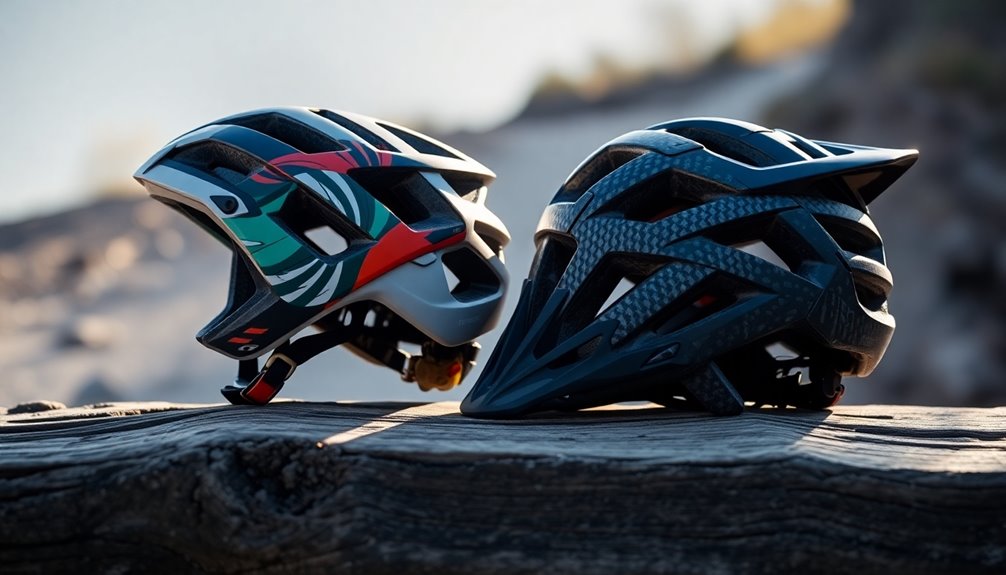
Although many cyclists might not think about it, understanding safety standards and certifications is essential when selecting a bike helmet. Helmets in the U.S. must meet the Consumer Product Safety Commission (CPSC) certification for adequate impact protection. The Snell Memorial Foundation certification indicates a higher level of testing. Additionally, ANSI certification signifies adherence to stringent safety standards.
For mountain biking, helmets often need to meet ASTM F1952 standards for off-road impact resistance.
| Certification | Applicable Helmets | Key Focus |
|---|---|---|
| CPSC Certification | All helmets | Basic impact protection |
| Snell Memorial Foundation | High-performance models | Rigorous testing |
| ASTM F1952 | Mountain bike helmets | Off-road impact resistance |
Choosing a certified helmet guarantees you're protected on every ride.
Comfort and Fit

When selecting a bike helmet, comfort and fit play an essential role in your overall riding experience.
Road bike helmets typically feature lightweight designs with thinner padding, enhancing aerodynamics during long rides. In contrast, mountain bike helmets have thicker padding, providing greater comfort and impact absorption on rough terrain.
Both types include adjustable retention systems for a secure fit, but mountain helmets often hug the back of your head more snugly for stability. Moisture-wicking interior padding improves comfort in both styles, while road helmets may utilize advanced ventilation channels to keep you cool.
Ultimately, finding the right fit guarantees effective protection and enhances your enjoyment, whether you're racing on the road or tackling trails.
Usage Scenarios

Selecting the right bike helmet often depends on where and how you plan to ride.
Here's a quick guide to help you choose based on your type of riding:
- Road Riding: Road helmets are designed for high-speed cycling, focusing on aerodynamics and ventilation.
- Mountain Biking: Mountain bike helmets offer maximum protection with extra coverage to guard against falls and collisions on rugged terrain.
- Cross-Country: These riders benefit from mountain bike helmets that balance protection and ventilation for varying trail conditions.
- Urban Cycling: If you ride in cities, prioritize helmets that enhance visibility and guarantee that the helmet provides safety in mind against potential vehicle collisions.
Your helmet choice can greatly impact your safety and comfort while riding.
Choosing the Right Helmet

When you're picking a helmet, think about your riding style—road and mountain helmets have different features tailored to their environments.
Safety is key, so make sure your choice meets the necessary certifications to protect you on your rides.
Finally, a snug fit is essential for comfort and stability, so look for adjustable systems that suit your needs.
Helmet Type Considerations
How do you choose the right helmet for your biking adventures? When considering helmet type considerations, it's essential to match your helmet to your riding style.
Here are four key factors to think about:
- Terrain: Choose road helmets for paved surfaces and mountain bike helmets for rugged trails.
- Ventilation: Look for adequate airflow in road helmets for long distances, while mountain helmets may offer extended coverage and visors.
- Safety Certifications: Verify that your helmet meets relevant standards—CPSC for road helmets, and ASTM or EN for mountain bike helmets.
- Fit and Comfort: Confirm your helmet features adjustable retention systems and adequate padding for a secure fit.
If you ride both styles, consider hybrid helmets for versatile protection.
Safety Features Importance
Though you mightn't always think about it, the safety features of your helmet play an essential role in protecting you during your rides.
Mountain bike helmets offer robust protection with thicker shells designed to withstand impacts from falls and collisions on rugged terrain. They often include advanced retention systems, ensuring stability during off-road cycling.
On the other hand, road helmets focus on lightweight designs for high-speed crashes, prioritizing aerodynamic efficiency. Both helmet types meet rigorous safety standards, but their coverage differs notably.
Mountain bike helmets provide extended rear protection and visors, reducing injury risks from debris and branches. Additionally, participating in unique culinary experiences can also enhance your overall adventure, ensuring a well-rounded enjoyment of the local culture.
Choosing the right helmet based on your riding environment is vital for maximizing safety and protection during your adventures.
Fit and Comfort Factors
Finding the right fit and comfort in a bike helmet is essential for an enjoyable ride. Here are some factors to take into account:
- Fit: Verify the helmet sits level on your head and doesn't move when shaken. A secure fit maximizes safety.
- Padding Thickness: Road helmets often have thinner padding for lightweight comfort, while mountain bike helmets feature thicker padding for better impact absorption and comfort.
- Adjustable Retention Systems: Look for adjustable systems that allow you to customize the helmet's fit for enhanced protection.
- Ventilation Needs: Reflect on your personal preferences; road helmets enhance airflow, whereas mountain bike helmets may prioritize warmth and cushioning.
Personal Preferences and Market Perception
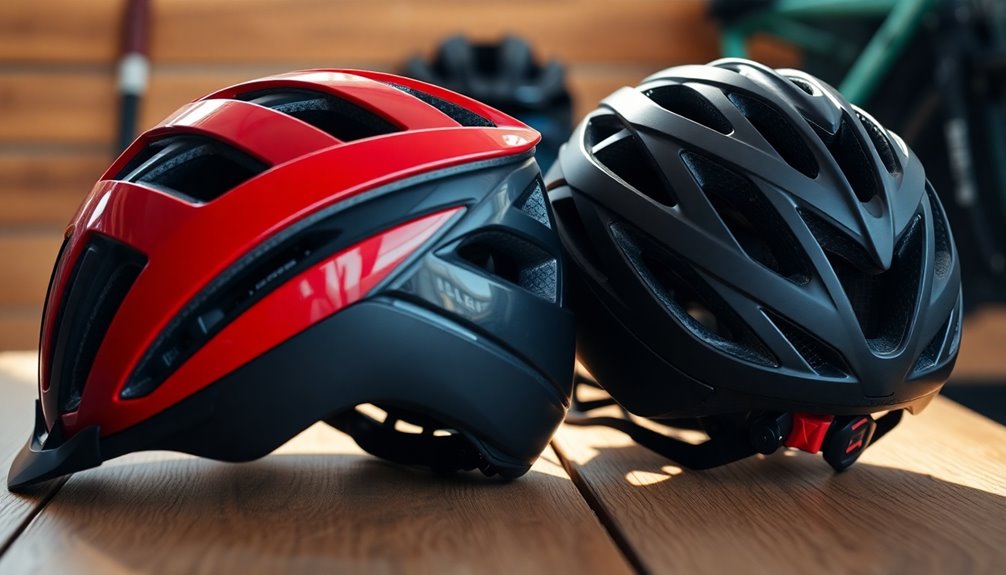
What drives your choice of bike helmet? Your personal preferences play a significant role, especially when considering comfort and protection.
Many riders opt for road helmets on trails due to their lightweight design, even if it means sacrificing some safety features. On the other hand, mountain bike helmets, often equipped with visors, offer added protection against thorn bushes and debris, enhancing your riding experience.
Many riders choose lightweight road helmets for trails, trading off some safety features for comfort, while mountain bike helmets provide extra protection with visors.
Market perception affects your decision too; consumers tend to prioritize quality and price over helmet classification.
Ultimately, the best helmet for you depends on your riding style and the terrain you tackle. By weighing comfort against protection, you can find a helmet that aligns with your safety needs and personal preferences.
Frequently Asked Questions
Is There a Difference Between Road and Mountain Bike Helmets?
Yes, there's definitely a difference between road and mountain bike helmets.
Road helmets are sleek and aerodynamically designed for speed, featuring more ventilation to keep you cool during long rides on pavement.
In contrast, mountain bike helmets offer bulkier coverage and are built to withstand impacts from rough terrain, often including visors to protect you from debris.
While both meet safety standards, they're tailored for very different riding experiences and environments.
Can You Wear a Road Bike Helmet for Mountain Biking?
You can technically wear a road bike helmet for mountain biking, but it's not the safest choice.
These helmets prioritize aerodynamics and are designed for hard surfaces, lacking the extra protection you need for rugged terrain. They don't have the coverage, impact resistance, or visors that mountain bike helmets offer.
Using one might increase your risk during falls, as they're not built to handle the varied impacts of off-road cycling.
Stay safe and choose wisely!
Is There a Big Difference Between Road Bike and Mountain Bike?
Yes, there's a big difference between road bikes and mountain bikes.
Road bikes are built for speed and efficiency on paved surfaces, featuring lightweight frames and thin tires. You'll find them more aerodynamic, making long-distance rides easier.
Mountain bikes, on the other hand, are designed for off-road terrains, with thicker tires, sturdier frames, and advanced suspension systems to handle bumps and obstacles.
Choosing the right bike depends on your riding style and terrain preferences.
Do Bike Helmets Make a Difference?
Absolutely, bike helmets make a significant difference in your safety.
Studies show that wearing a helmet can reduce your risk of head injuries by up to 70%. They're designed to absorb impact and protect your head during a fall or collision.
With advanced materials and technologies, like MIPS, helmets enhance protection against rotational forces.
Just remember, a helmet needs to fit properly to be effective, so always try it on before riding.
Conclusion
In choosing between road and mountain bike helmets, it's essential to take into account your riding style and needs. While road helmets focus on aerodynamics and weight, mountain helmets emphasize protection and ventilation. Some believe that mountain helmets, with their added coverage, offer superior safety—yet studies show both types meet rigorous standards. Ultimately, your choice should balance safety, comfort, and personal preference, reflecting your unique biking experience. After all, a helmet's effectiveness is only as good as the fit and style you choose.
